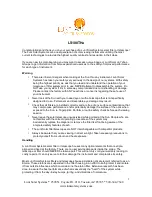
12
after midnight, when much of the heat absorbed by the Earth
during the day has radiated off into space.
Especially important for observing faint objects is good
“transparency”— air free of moisture, smoke, and dust. All
tend to scatter light, which reduces an object’s brightness.
Transparency is judged by the magnitude of the faintest stars
you can see with the unaided eye (6th magnitude or fainter is
desirable).
Cooling the Telescope
All optical instruments need time to reach “thermal equilibri-
um”. The bigger the instrument and the larger the temperature
change, the more time is needed. Allow at least 30 minutes
for your telescope to cool to the temperature outdoors. In very
cold climates (below freezing), it is essential to store the tele-
scope as cold as possible. If it has to adjust to more than a 40°
temperature change, allow at least one hour.
Let Your Eyes Dark-Adapt
Don’t expect to go from a lighted house into the darkness of
the outdoors at night and immediately see faint nebulas, gal-
axies, and star clusters—or even very many stars, for that mat-
ter. Your eyes take about 30 minutes to reach perhaps 80% of
their full dark-adapted sensitivity. As your eyes become dark-
adapted, more stars will glimmer into view and you’ll be able to
see fainter details in objects you view in your telescope.
To see what you’re doing in the darkness, use a red-filtered
flashlight rather than a white light. Red light does not spoil your
eyes’ dark adaptation like white light does. A flashlight with a
red LED light is ideal, or you can cover the front of a regular
incandescent flashlight with red cellophane or paper. Beware,
too, that nearby porch and streetlights and car headlights will
ruin your night vision.
Eyepiece Selection
By using eyepieces of varying focal lengths, it is possible to
attain many magnifications with the SpaceProbe 130ST EQ.
The telescope comes with two high-quality Plössl eyepieces:
a 25mm, which gives a magnification of 26x, and a 10mm,
which gives a magnification of 65x. Other eyepieces can be
used to achieve higher or lower powers. It is quite common for
an observer to own five or more eyepieces to access a wide
range of magnifications. This allows the observer to choose the
best eyepiece to use depending on the object being viewed.
To calculate the magnification, or power, of a telescope and
eyepiece combination, simply divide the focal length of the
telescope by the focal length of the eyepiece:
focal length of telescope
Magnification =
focal length of eyepiece
For example, the SpaceProbe 130ST EQ, which has a focal
length of 650mm, used in combination with the 25mm eye-
piece, yields a magnification of
650mm = 26x
25mm
Every telescope has a useful limit of magnification of about 2x
per millimeter of aperture. Which comes to about 260x for the
SpaceProbe 130ST. Claims of higher power by some telescope
manufacturers are a misleading advertising gimmick and should
be dismissed. Keep in mind that at higher powers, an image will
always be dimmer and less sharp (this is a fundamental law of
optics). The steadiness of the air (the “seeing”) can also limit
how much magnification an image can tolerate.
Whatever you choose to view, always start by inserting your
lowest-power (longest focal length) eyepiece to locate and
center the object. Low magnification yields a wide field of view,
which shows a larger area of sky in the eyepiece. This makes
acquiring and centering an object much easier. If you try to
find and center objects with high power (narrow field of view),
it’s like trying to find a needle in a haystack!
Once you’ve centered the object in the eyepiece, you can
switch to higher magnification (shorter focal length eyepiece),
if you wish. This is especially recommended for small and
bright objects, like planets and double stars. The Moon also
takes higher magnifications well.
Deep-sky objects, however, typically look better at medium or
low magnifications. This is because many of them are quite
faint, yet have some extent (apparent width). Deep-sky objects
will often disappear at higher magnifications, since greater
magnification inherently yields dimmer images. This is not
the case for all deep-sky objects, however. Many galaxies are
quite small, yet are somewhat bright, so higher power may
show more detail.
The best rule of thumb with eyepiece selection is to start with
a low power, wide field, and then work your way up in magnifi-
cation. If the object looks better, try an even higher magnifica-
tion. If the object looks worse, then back off the magnification
a little by using a lower-power eyepiece.
Figure 19.
Star hopping is a good way to locate hard-to-find
objects. Refer to a star chart to map a route to the object that uses
bright stars as guideposts. Center the first star you’ve chosen
in the finder scope and telescope eyepiece (1). Now move the
scope carefully in the direction of the next bright star (2), until it
is centered. Repeat (3 and 4). The last hop (5) should place the
desired object in the eyepiece.





























